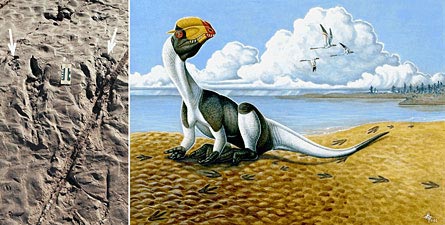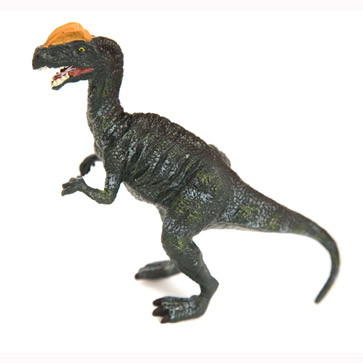Jurassic Handprint Demonstrates Link to Birds
Marks left in the mud next to an ancient Jurassic lake by a meat-eating dinosaur and preserved as fossils; reveal that dinosaurs had hands that were not suitable for walking upon very early in their evolution. In a report published in the online palaeontological journal PLos ONE, a team of American scientists have concluded that the fossil handprints, perhaps the best theropod handprints discovered to date, indicate that these dinosaurs abandoned the use of their forelimbs as legs early in their evolutionary development.
The term theropod (it actually means “Beast Foot”), or to be more scientifically accurate and to use the formal classification – Theropoda; refers to a group of lizard-hipped, bipedal dinosaurs. The majority of the sub-order Theropoda are meat-eaters, dinosaurs such as Tyrannosaurus rex, Spinosaurus and Megalosaurus are theropods. The primary classification of dinosaurs took place in the latter half of the 19th century when our knowledge of these animals and their diversity was only just beginning to develop.
The term theropod for example, was first attributed to the American palaeontologist Charles Othniel Marsh. He used the classification Theropoda to help determine the relationship of the Allosauridae fossils from the Western USA to other types of dinosaur. The term replaced the earlier classification for large, bipedal dinosaurs of Goniopoda “angled feet” which had been proposed by Marsh’s great rival Edward Drinker Cope. Ironically, the term Goniopoda is more appropriate, as scientists are now certain that it is the theropods or the “Beast Feet” that are the ancestors of birds.
Commenting on the scientific paper, the lead author, Andrew R. C. Milner of the St George Dinosaur Discovery Site at Johnson Farm in Utah, stated that due to the disproportionately small forelimbs of most theropods trace fossils of them as they rested on the ground are extremely rare. Only a few other examples of theropod handprints are known, but the discovery of a beautifully preserved set of impressions in 2004, have enabled scientists to shed more light on the range of movement of dinosaur hands and arms.
Impressions in the Sediment
Vertebrate palaeontologist Milner and his colleagues describe in the paper, a clear set of 5 cm deep impressions preserved amongst hundreds of other trace fossils in the sediment that has been dated to the early Jurassic (Sinemurian faunal stage), approximately 198 million years ago. The rock preserves trace fossils of worm borings, tracks made by crabs as well as body fossils of fish. The sediment represents a part of a shoreline adjacent to an ancient lake. The water level seems to have altered and as a result the sediment shows signs that the water levels fell and the muddy sand cracked and dried in the sun.
Milner commented:
“The now-hardened rocks preserve many details of the lakeside topography of that time”.
The theropod handprints, form part of a fossilised trackway that appears to have been made when the dinosaur walked up a slight incline and then crouched down to rest. Although the actual genera of dinosaur cannot be identified from the footprints and no theropod dinosaur bones have been associated with the trackway, the Utah based team have calculated that the marks were made by a meat-eating dinosaur that would have measured approximately 4.5 metres long. Little is known about dinosaurs from this time in the early Jurassic, the fossil record is particularly poor.
However, Dilophosaurs are known to have lived in this part of the world at the time the handprints were made and the scientists have speculated that a Dilophosaurus or some such similar animal could have made the tracks.
An Illustration of Dilophosaurus

Picture credit: Everything Dinosaur
To see a model of a Dilophosaurus: Dinosaur and Prehistoric Animal Models.
A Model of A Dilophosaurus (Procon/Collecta Range)
Picture credit: Everything Dinosaur
In the model above, the sculptor has attempted to show the hands of the Dilophosaurus slightly turned into the body, moving away from the classic “bunny” position of most theropod dinosaur models, and indeed museum exhibits. In this, the sculptor has attempted to demonstrate the limited range of movement of the forelimbs of saurischian, theropods.
Dinosaur Handprint
Each handprint was made by the edge of the hand, not its palm, and indicates that the fingers on each forelimb curled inward, says Milner. This configuration backs up anatomical studies of later theropods, suggesting that those creatures couldn’t rotate their palms to face downward, indeed the range of movement of theropod forelimbs was very different to the range of the arm movement in humans.
In discussing the findings, Thomas R. Holtz Jr. (vertebrate palaeontologist at the University of Maryland) stated:
“If there is any situation when you would expect a theropod to plant its palm facedown, then this is it – and the fact that it didn’t in this case is strong evidence that it couldn’t”.
In the typical tone associated with many palaeontologists who get really excited about new discoveries Holtz went on to state that:
“It is a really neat paper, it shows that even early theropods had abandoned the use of the forelimbs as legs”.
The Fossilised Handprints and an Illustration of the Dilophosaur Resting

Picture credit: H. K. Luterman of Cedar City, Utah
The fossilised handprints (picture left, see arrows), were presumed to be made by a resting theropod dinosaur. The prints left in the sediment indicate that this dinosaur could not rotate its palm to face downwards. The illustration on the right shows how a crouching theropod might have made such marks in the sand.
In contrast to the way that most theropods are depicted in books, pieces of art and even in museum exhibits, the range of movement of theropod’s arms was limited in comparison to our own. Theropods and other bipedal lizard-hipped dinosaurs could not rotate the forearm so that the palms faced the ground or backwards towards their hind legs. This ability to rotate the hands is called pronation. It is achieved by motion of the two bones in the forearm, the radius and the ulna in relation to each other. From studies of dinosaur bones it seems that in most theropods the radius and ulna were less mobile in relation to each other, so movement was limited. The freedom of movement around the shoulder joint and the wrist bones was also much reduced when compared to human anatomy. However, studies of the structure of some theropod forelimbs, such as the early Cretaceous meat-eater Acrocanthosaurus show that the digits could be flexed backwards against the wrist, perhaps an adaptation to enable the sharp claws on this dinosaur’s three fingers to dig into struggling prey.
Theropod Arm Movement
Scientists have speculated that the range of arm movement in many theropods reflects their relationship with the Aves (birds). In theropods, the only way for the palm to face the ground would perhaps have been by splaying out the entire forelimb, as in a bird raising its wing. The range of possible movement for forelimbs in later theropods such as the Troodonts does reflect their close kinship to birds.
It seems from the trace fossils found at the site of an ancient lake in Utah, the forelimbs in certain dinosaurs had become much more specialised and no longer useful for walking upon much earlier in their evolution than previously thought.







I have a few questions to spark some new thoughts.
There are other tracks found 2002 showing a theropod standing over an area where it had slashed 3 parallel on each claw that are all parallel with the point direction from their toes.
1.) Would this set of tracks and theory behind them make the 2002 tracks void with alternate explanation?
2.)Would all theropods have the inability to promote their arms based from a few unidentified species tracks?
3.) Do you think quadrapedal locomotion would be better suited for derived species like Deinonychus, Utah raptor, baryonyx..etc. exp.large forearmed theropods?
Much like spinosaurus in which I’m not sure if it’s classified as a theropod any more.
4.)What is the link between avian wings and the inability to pronate their theropdic arms?
Flying bird wings have a large range of mobility including the ability to pronate. They must have that range of motion to maintain control in flight.
Even flightless birds like the domestic chicken, penguins, ostrich, emu, casuary they can all pronate.
If anything evidence supporting theropods ability to pronate would help support the theory that birds came from the theropods and we could move on to a new topic to study.